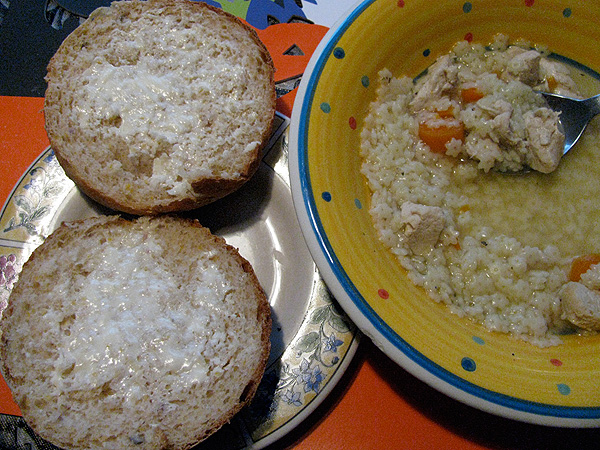Pizza making video
Here is a short Pizza Baker video titled "Naturally Risen". I received it from Pizzatherapy.com. Enjoy!
- Log in or register to post comments
- 2 comments
- View post
- JoPi's Blog
Here is a short Pizza Baker video titled "Naturally Risen". I received it from Pizzatherapy.com. Enjoy!
I made Struan Rolls to go with a pot of soup Dorota made tonight.


Often my Struan comes out a bit heavy (like in the photo in the recipe I linked to), but tonight I nailed it. They were light, fluffy, soft, and just the perfect sweetness. When you get Struan right, it is hard to beat.
This is my first blog, so bear with me ....
I'm about 6 weeks in as an amateur bread baker. I started in an effort to save my family some money, and find a new hobby. After my first loaf of pain sur poolish, I was hooked. So far I've made some pretty good breads, and they seem to have gotten a little better each week as I practice my technique.
I made four loves yesterday and they all turned out. After reding sooooooooooo many recipes, I came up with one that seems to work. The recipe needs just a little tweek. Little more water and salt. I did not retard in the frig but next weekend I will not skip this step. I just couldn't wait!
I remember rustic bread from "Bread" being a staple in my kitchen before I got started with levains and sourdough breads. It's a clean, wholesome bread, and it's over a year since I'd made his rustic bread, so the time was ripe for another attempt.
I wanted to try some different shapes as well, so I divided the dough in two, both weighing 750 gr. each. One was shaped as an ordinary batard, and the other piece was cut into smaller dough chunks, and shaped into mini-batards and the tabatiere and pain d'Aix shapes shown in ABAP.
David Snyder (dmsnyder) has convinced me pre-steaming is beneficial, but I've still been uncertain I'm generating enough steam, considering my oven door is not an airtight fit, and the convection fan blows some of the steam out around the door. So, today, I tried a new way to generate steam. I saw it recommended in Hamelman's Bread, but I ignored it happy as I was, at the time, generating steam with pre-heated lava rocks. It was only when David wrote of his experience pre-steaming his oven that I started reexamining the details of my steaming practice.
Last weekend I gave Susan’s Sourdough Boule another try after it had come out with a crumb that was too dense the first time around. Since the ingredients were exactly the same as in one of Susan’s recipes (I used KA bread flour and pre-soaked flax seeds), the culprit could only be the starter. This time I made sure it was up to speed and strength after feeding it twice before using it and it happily produced the desired results:
Ok, here I am with my first post!
I am a new entry in TFL, but I have been reading your Blogs, Receipts and Q&A since about 1 year. I am italian, I live in the north of Italy and I love bread and baking.
My San Francisco Sourdough starter from sourdo.com is now two weeks old. I made another pair of my San Joaquin Sourdough breads with it yesterday. I modified my formula somewhat. I used a 60% hydration starter fed with AP flour only. I increased the amount of starter by 50%. I used KAF AP flour for the dough. I used no added instant yeast.
|
Ingredients |
Weight |
As most, if not all, of you know Italians traditionally dip biscotti into their coffee or wine, i suspect, in part, to soften it a bit before chewing. October, November and December of year, along with holiday baking, we're putting the finishing touches to plans for our annual January open house wherein we serve only our homemade wines, homebrewed beer, and a cornucopia of food, all made from scratch.
This year's theme is Wine and Bread.